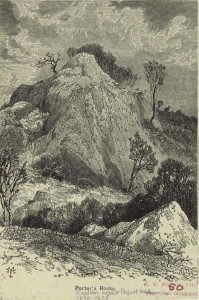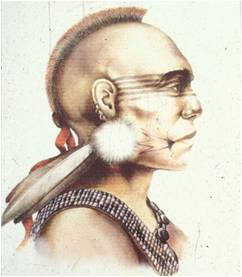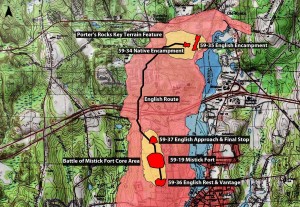Porter’s Rocks Site
Porter’s Rocks
The rock formations on the western shore of the Mystic River are known locally as “Porter’s Rocks.”
This place name is rooted in the Pequot War and the Mistick Fort Campaign.
On the evening of May 25, 1637 approximately 350 English-Allied Forces crossed the Mistick River somewhere in the vicinity of present-day Old Mystic on their march towards the fortified Pequot village further to the south. It was late in the evening and many English soldiers were exhausted from marching all day in the heat while carrying their heavy arms and equipment.
The English-Allied Pequot guide and scout, Wequash, lead the attack force along the Mistick River and up to a series of steep cliffs. Within this rock formation the English and Natives encamped for the night. At this time the English-Allied force consisted of approximately 2 Pequot Guides / Scouts, 80-100 “River Indians” (Mohegan, Poquonnock, Suckiaug, Podunk, Wangunk, & others), 200 Narragansett and Western Niantic, and 77 English.

Sketch of the Porter’s Rocks outcroppings and campsite from the “Popular History of the United States 1876”
As the English and Native allies broke into several encampments, soldiers and warriors were deployed as sentries to the highest parts of the cliff. There they could hear songs from celebrations or ceremonies taking place down the river valley from Mistick Fort.
Little did they know that the Misitick Fort had been reinforced earlier that day with 150 veteran Pequot warriors sent by Sassacus to investigate rumors of English forces in the vicinity of Pawcatuck. The Pequot company planned to scouting east of the Mystic River the following morning.
On the morning of May 26, 1637 English-Allied forces broke camp at approximately 3:00 AM and began their approach to Mistick Fort, lead by their Pequot guide, Wequash. Neither English commanders or their Native allies were aware of the additional 150 warriors and only expected to battle the usual compliment of 50 to 75 defenders. This would significantly impact the outcome of the Battle of Mistick Fort.
Porter’s Rocks: Sites 59-34 and 59-35
These sites are denoted as separate Native and English-allied encampments, where English-allied forces, including Captain John Mason, Captain John Underhill, Mohegans, Narragansetts and various “River Indians” spent the night before marching south towards Mistick Fort in the early morning of May 26, 1637.




